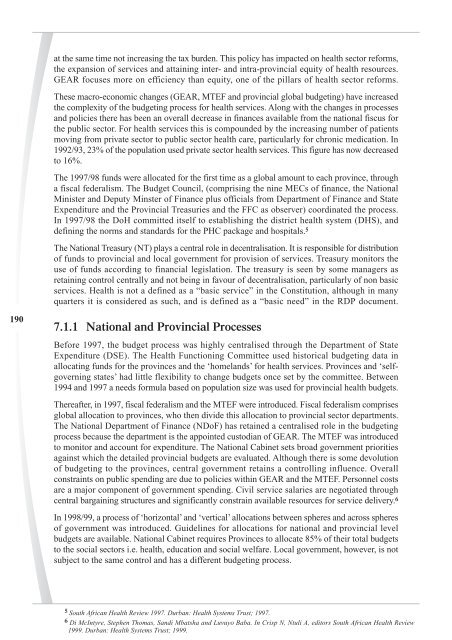RHD Prelude Chapter - Health Systems Trust
RHD Prelude Chapter - Health Systems Trust
RHD Prelude Chapter - Health Systems Trust
Create successful ePaper yourself
Turn your PDF publications into a flip-book with our unique Google optimized e-Paper software.
at the same time not increasing the tax burden. This policy has impacted on health sector reforms,<br />
the expansion of services and attaining inter- and intra-provincial equity of health resources.<br />
GEAR focuses more on efficiency than equity, one of the pillars of health sector reforms.<br />
These macro-economic changes (GEAR, MTEF and provincial global budgeting) have increased<br />
the complexity of the budgeting process for health services. Along with the changes in processes<br />
and policies there has been an overall decrease in finances available from the national fiscus for<br />
the public sector. For health services this is compounded by the increasing number of patients<br />
moving from private sector to public sector health care, particularly for chronic medication. In<br />
1992/93, 23% of the population used private sector health services. This figure has now decreased<br />
to 16%.<br />
The 1997/98 funds were allocated for the first time as a global amount to each province, through<br />
a fiscal federalism. The Budget Council, (comprising the nine MECs of finance, the National<br />
Minister and Deputy Minster of Finance plus officials from Department of Finance and State<br />
Expenditure and the Provincial Treasuries and the FFC as observer) coordinated the process.<br />
In 1997/98 the DoH committed itself to establishing the district health system (DHS), and<br />
defining the norms and standards for the PHC package and hospitals. 5<br />
The National Treasury (NT) plays a central role in decentralisation. It is responsible for distribution<br />
of funds to provincial and local government for provision of services. Treasury monitors the<br />
use of funds according to financial legislation. The treasury is seen by some managers as<br />
retaining control centrally and not being in favour of decentralisation, particularly of non basic<br />
services. <strong>Health</strong> is not a defined as a “basic service” in the Constitution, although in many<br />
quarters it is considered as such, and is defined as a “basic need” in the RDP document.<br />
190<br />
7.1.1 National and Provincial Processes<br />
Before 1997, the budget process was highly centralised through the Department of State<br />
Expenditure (DSE). The <strong>Health</strong> Functioning Committee used historical budgeting data in<br />
allocating funds for the provinces and the ‘homelands’ for health services. Provinces and ‘selfgoverning<br />
states’ had little flexibility to change budgets once set by the committee. Between<br />
1994 and 1997 a needs formula based on population size was used for provincial health budgets.<br />
Thereafter, in 1997, fiscal federalism and the MTEF were introduced. Fiscal federalism comprises<br />
global allocation to provinces, who then divide this allocation to provincial sector departments.<br />
The National Department of Finance (NDoF) has retained a centralised role in the budgeting<br />
process because the department is the appointed custodian of GEAR. The MTEF was introduced<br />
to monitor and account for expenditure. The National Cabinet sets broad government priorities<br />
against which the detailed provincial budgets are evaluated. Although there is some devolution<br />
of budgeting to the provinces, central government retains a controlling influence. Overall<br />
constraints on public spending are due to policies within GEAR and the MTEF. Personnel costs<br />
are a major component of government spending. Civil service salaries are negotiated through<br />
central bargaining structures and significantly constrain available resources for service delivery. 6<br />
In 1998/99, a process of ‘horizontal’ and ‘vertical’ allocations between spheres and across spheres<br />
of government was introduced. Guidelines for allocations for national and provincial level<br />
budgets are available. National Cabinet requires Provinces to allocate 85% of their total budgets<br />
to the social sectors i.e. health, education and social welfare. Local government, however, is not<br />
subject to the same control and has a different budgeting process.<br />
5 South African <strong>Health</strong> Review 1997. Durban: <strong>Health</strong> <strong>Systems</strong> <strong>Trust</strong>; 1997.<br />
6 Di McIntyre, Stephen Thomas, Sandi Mbatsha and Luvuyo Baba. In Crisp N, Ntuli A, editors South African <strong>Health</strong> Review<br />
1999. Durban: <strong>Health</strong> <strong>Systems</strong> <strong>Trust</strong>; 1999.
















